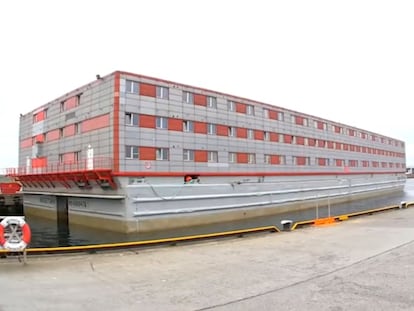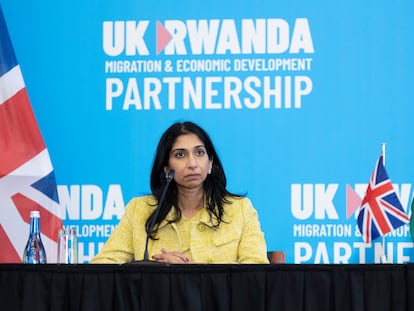The fences dividing Europe: how the EU uses walls to contain irregular migration
The financing of new physical barriers at the European Union’s external borders is once again straining the migration debate
The specter of walls is haunting Europe again. Three decades after the fall of the Berlin Wall, the question resurfaces: Should the European Union erect barriers to protect its external borders?
The reality is that it is already doing so – in the last eight years member states have built more than 1,700 kilometers of walls to protect themselves not against tanks or soldiers, but against migrants and refugees. But who pays for this? Should European funds finance barriers of cement, steel and razor wire in the same way as they finance the purchase of radars and drones. The debate is heated, but the conclusions of the last meeting of the European Council, on February 9, suggest that those supporting a draconian approach are gaining ground.
The European Commission, and countries such as Spain and Germany, are against the use of EU money to build more walls, believing that there are more effective tools to curb irregular immigration. But those in favor, headed by the Visegrad group comprised of the Czech Republic, Poland, Slovakia and Hungary and supported by Italy, Greece and Austria, argue their position using a kind of domestic logic: to be able to close doors, they must first exist. Ultimately, the issue is more about where Europe is heading in the face of the migration challenge, and whether it will continue to use ever tougher policies to meet it. Right now, everything points to the affirmative.
The temptation to divide the world into plots of land and sea has been ever present in the European Union, which has been shaped by eliminating internal borders while fortifying external ones. Nervousness regarding these external borders resurfaces on a regular basis. The recent meeting of the European Council is one example while the previous episode was little more than a year ago, when in October 2021 the interior ministers of 12 countries wrote to the European Commission demanding that the study of how to finance “physical barriers” for external borders should be made a “priority.”
Physical barriers have been protecting part of Europe’s external border for decades. The Spanish enclaves in North Africa of Ceuta (1993) and Melilla (1996) were among the first to have these erected. Subsequently, these barriers have expanded to cover more than 2,000 kilometers. Bulgaria, for example, the poorest country in the EU, maintains a fence extending around 98% of its border with Turkey. The refugee crisis of 2015, with the arrival of more than a million people – many fleeing the war in Syria – led to a renewed impetus to build walls to stop those trying to enter the continent. Fencing intensified in Hungary, Latvia, Slovenia, Austria and even in France.
Years later, with migration at relatively low levels, Europe saw how partners and neighbors used the immigration issue as a weapon to destabilize the continent and demand concessions. It happened in 2020 when Turkey opened its borders and threatened Europe with the arrival of millions of refugees and when Morocco let more than 10,000 people cross into Ceuta in May 2021. The latest episode, framed in combative terms as a “hybrid threat,” was experienced in the summer and fall of 2021, when Belarus encouraged tens of thousands of people to enter Poland, Lithuania and Latvia during the 2021-2022 Belarus-European Union border crisis. The response was to build or extend walls hundreds of kilometers long between the three countries and Belarus. Now, the war in Ukraine has resurrected fears in some countries that Moscow is using immigration as an extra weapon in its arsenal against Europe. Finland has already announced plans to build a fence separating it from Russia given that it has the longest border of all states with what is the largest country in the world.
The European Union does not hesitate to invest large sums of money to curb migratory flows and the €6.7 billion that the Commission has earmarked for border management from 2021 to 2027 serve as an example. But until now, paying for steel walls topped with barbed wire was a taboo subject.
The European directive is ambiguous and, although several EU sources consider that there would be no legal impediment to financing physical barriers, the Commission is reluctant. On February 9, the President of the European Executive, Ursula von der Leyen, insisted once again that what is needed is an “integrated approach” involving the mobilization – and reinforcement, where necessary – of Frontex, the European border agency, as well as the financing of both mobile and static infrastructure such as towers with surveillance equipment and vehicles. She talks about infrastructure, but not about “walls” or “fences,” wincing every time they are mentioned, as was seen during the last European Council.
The Commission does not finance walls
Walls are already dividing Europe ideologically. But Von der Leyen diverges from the line taken by her political family, the European People’s Party (EPP), one of the main supporters of fences. However, the Commission’s refusal to allocate European funds to build them is also a pragmatic position, according to EU sources. Erecting fences thousands of kilometers long would cost a small fortune that could be spent on other projects. Brussels believes, for example, that it is much more efficient to invest in agreements with the irregular migrants’ countries of origin so that these would accept the return of their nationals.
The arguments of those who oppose the walls are similar: they are expensive, they are divisive and, not only do they not prevent people from crossing them, but they also foster the creation of new, longer, more costly and more dangerous routes, producing two clear winners – the companies that build them and the traffickers who circumvent them.
“Walls and barriers rarely work that well,” says Klaus Dodds, Professor of Geopolitics at London’s Royal Holloway University and author of the book Border Wars: The conflicts of tomorrow. “They generate grievance and anger among migrants and give local communities false hope.” The expert believes that they take on “an exaggerated symbolic importance” and adds “governments want to be seen to be doing something, but for communities living on both sides of a border, such as the US-Mexico border area, it can be complicated, as families and communities have links to both sides and the wall acts as a wound that does not heal.”
Gil Arias, former executive director of Frontex, also declares himself a “skeptic” when it comes to fences. “Physical obstacles have never been a radical deterrent,” he says. “We have seen this in Ceuta and Melilla over the years; if they feel the need to jump, they do so even at the risk of losing their life, as happened on June 24 in Melilla.” Arias believes that borders should be defended with intelligence and not with barbed wire.
Walls also have direct implications regarding respecting the rights and dignity of migrants and their ability to seek asylum when fleeing wars and conflicts. “Fences do not distinguish between people who have the right to seek asylum and those who do not,” says Ainhoa Delas, a researcher at Centre Delàs, a peace, security, defense and armament analysis entity. “Financing walls is a contradiction between the values the EU claims to defend and what it actually ends up doing.” Tragedies have occurred on account of these fences, several of the most significant occurring in Spain. The last and most serious was last June 24, when at least 23 people died in an attempt to cross the border from Nador to Melilla.
Spain aligns itself with the Commission regarding the building of physical barriers and argues that walls do not provide a solution to the migratory challenge. But the official Spanish line departs somewhat from what happens in practice. Over the years, Spain has done nothing but invest in reinforcing and modernizing the almost 21 kilometers of fence built in Ceuta and Melilla. The latest investment did away with the barbed wire that was tearing the skin of the immigrants, and a different design was adopted that, according to Interior Ministry sources, would make it impossible to jump the barrier. Spain argued before the EU that the new fence was safer and less harmful, but this did not take into account the fact that Morocco was meanwhile lacing its side of the border with barbed wire and digging deep trenches which the migrants themselves recognize will break their legs if they try to cross them. Even so, in 2022, almost 2,300 people irregularly crossed the land borders of Ceuta and Melilla. The uptick has been going on for two years now.
At the end of the day, Brussels’ arguments do not convince those countries wanting to implement tough policies. This became clear at the informal summit of heads of state and government held in Brussels on February 9. Led by Austria and Greece, eight countries – including Denmark, Estonia, Latvia, Lithuania (whose 550-kilometer fence along its border with Belarus is the longest in Europe), Malta, Slovakia – called for “tangible” progress in strengthening controls along the EU’s external borders. On the table was a request, championed by Austria, for the Commission to earmark €2 billion of emergency funds to rebuild a more secure fence for Bulgaria’s border with Turkey. But this is not the only context that has triggered nervousness: according to Frontex, almost half of the 330,000 illegal entries into European territory during 2022 were through the Western Balkan route from Albania, Bosnia-Herzegovina, Kosovo, North Macedonia, Montenegro, and Serbia, an increase of 136% over the previous year.
“It is not logical that the EU funds drones, technology and surveillance equipment, but refuses to fund the means to defend us; we need an integrated approach and fences should be included in the financial package,” said conservative Greek Prime Minister Kyriakos Mitsotakis. Backing this point of view was Chancellor Karl Nehammer who added, “Austria is a country that considers border barriers to be useful.”
The debate is not going to be easily resolved. For Professor Dodds, the risk is that walls and fences will only “further inflame passions” and continue to postpone more urgent debates on the long-term settlement of communities from around the world affected by war, natural disasters and global warming. The addressing of that issue, which the European Union should address in its new Migration and Asylum Pact, is moving much more slowly, largely on account of resistance from those who feel safer living behind a wall.
Sign up for our weekly newsletter to get more English-language news coverage from EL PAÍS USA Edition

